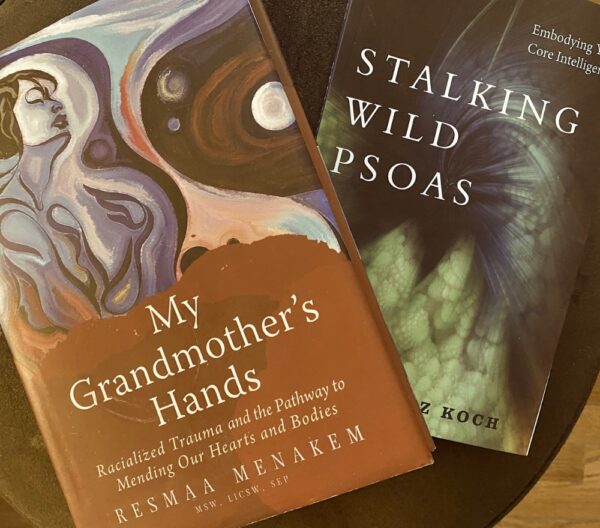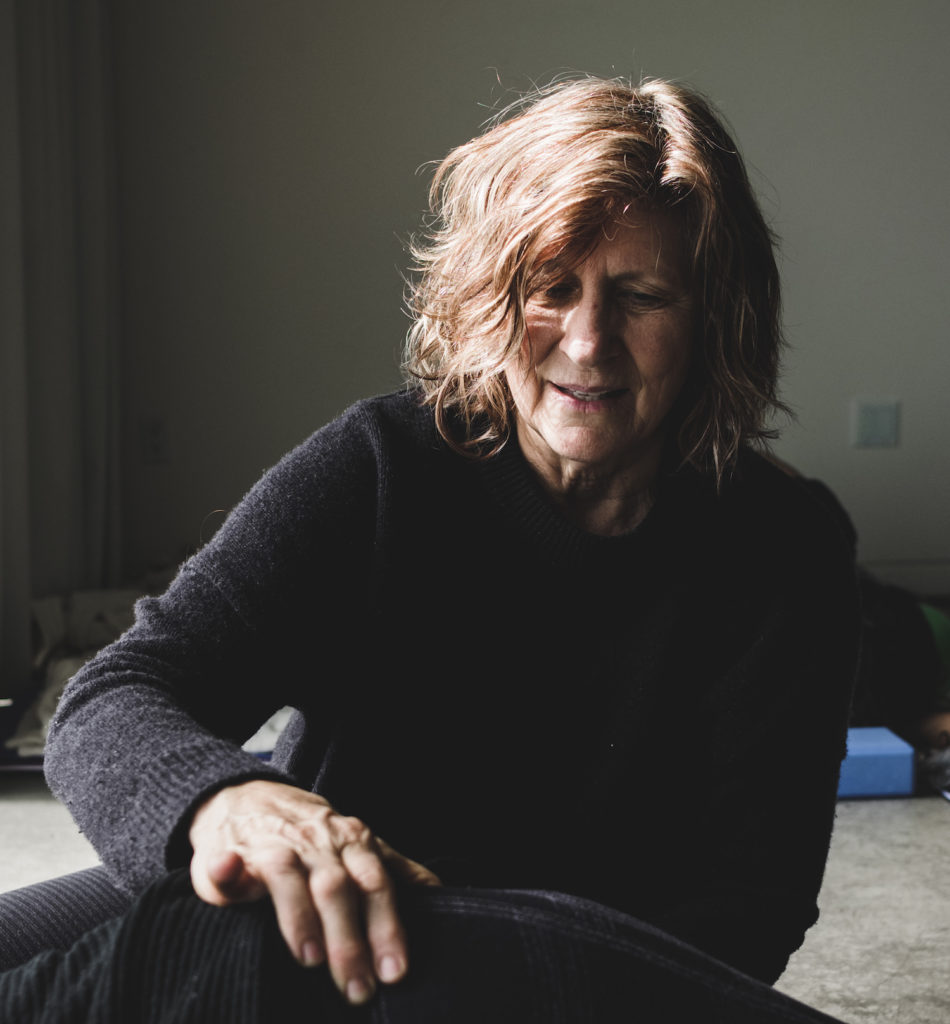Shortly after completing my final manuscript of Stalking Wild Psoas: Embodying Your Core Intelligence, a book that focuses on rewilding psoas by changing the language of body from object to living process, I came across My Grandmother’s Hands: Racialized Trauma and the Pathway to Mending Our Hearts and Bodies. It was the summer of 2018 and I was ready for what wanted to unfold.

Never before had I read such a direct weave of dialogue on somatic awareness and racism. No one I knew in my field of sensory perception had specifically and viscerally located and named racism in the body and not in the way author Resmaa Menakem had done. Being a somatic educator for over 45 years, I immediately recognized in his writing and his photo a man who embodies awareness, agency, and core integrity. My first thought was I must meet this man. Reaching out in the fall, I congratulated Resmaa on writing a seminal book and requested an opportunity to meet him in person. I planned on setting up a workshop in Minneapolis the following year in the hopes of sharing with him my work with the neuro-rich primal core tissue called psoas. I felt sure exploring primal expression is a rich bio-intelligent way out of trauma. He honored my request.
Taking the first flight out on a cold spring morning I drove into the city and arrived early at his office. When we met, we first spoke for a while and then headed out to lunch. Sitting across from Resmaa was such an honor. As I listened to his words, I began to recognize that how I thought about trauma was as an individual rather than through the lens of the cultural somatic body.
Resmaa was speaking to me about systemic racism and I was perceiving myself separate from any such construct. As a liberal woman, I was sure I was not a racist. So upon hearing the idea of spending the rest of my life building an abolitionist/anti-racist culture within white bodies, I felt a deep sense of exhaustion. He leaned in and looked me in the eye while I voiced what was on my mind: “white bodies are complacent” I quietly said.
Until this moment I had never really examined my roots of complacency. I simply had the privilege to choose to stay dis-engaged. I have never felt inclined to join groups. And I belong to no tribe. Belonging for me is a precarious word. It signals a warning. To belong to one group means not to belong to another. There is always an other who/that does not belong. But Mythic storyteller Martin Shaw speaks of those of us not claimed by our ancestral lands as scatterlings. And our current moment as humans as a time of amnesia. Struggling to find our ground, and remember our original knowing, leaves us fragile and windblown, our bodies roaming uprooted.
My ancestral lineage carries uprootedness as well as those who lived close to the earth. In my bones I know the deep longing to ground. The soulfulness of all living creatures entangled among trees, vibrating hills, and rich soil that holds me so that I too can compost the complexities of life and nourish the kinship of our spherical earth. Only then can I participate in regenerative processes.
Following these impulses, I cultivated my life work with core primal movements. Following a fine thread of a root back into my origins, through the elements of living beings, I have sensed my way to fall into deep sources of bio-dynamic expressions – life’s rippling waves and bio-morphic movements that go far beyond any specificity. These primal expressions of thriving go far beyond our social historical human condition.
Listening to Resmaa’s words I felt a mix of responses to his profound warmth and animated call to action. I found myself wondering what it might be to become fully responsive and to no longer feel complacent. This was not the first time I bumped up against my own whiteness.
While I was with my daughter in the inner city of St. Louis, I experienced a felt-sense of deep warmth in this extremely poor neighborhood marinating my white body in otherness. For the first time I began intentionally tracking my animal instincts in contrast to what felt like a rigidity, a holding, a stillness. It’s what I now refer to as dissonant whiteness. My years of tracking sensory information with awareness helped me recognize whiteness within. As I formed words to shape the tangible feeling of body objectification, I named it broadly as a desensitizing coldness, an isolating numbness, that fosters indifference. I realized that as a “product” of the materialistic world, I had been packaged in a white body, in a white culture programmed, marketed, and stamped as a useful tool of consumerism.
Thawing in the warmth of a heartfelt humanness, I recognized that it is my civilized animal body that roams ravenous. Starving for substance, my somatic experience was a scratching in a hardpan. There was a sense of density and yet something very alive felt buried below. What I did not viscerally claim until after I flew in to meet Resmaa was that this white body had actually never sat down with any black body and had a serious heart to heart conversation.
New York author and psychologist Natasha Stovall’s article “Whiteness on The Couch,” questions why white people in therapy do not speak about their race and how this dissonance affects every aspect of their well-being. It was after Natasha joined me to explore not only the psychological entanglements of whiteness but also the instinctive sensory distortions of our animal body’s expression that I began to perceive how years of colonization fostered complacency in white bodies so they were able to ignore the obvious.
Our elemental nature, tortured, shocked, and banished was captured. The colonized white body carries its unique historical conditioned fear of otherness not only without but also within. This separatism validates and justifies suppressing, eradicating, and commodifying all life through an exercise of powering over. By learning to negate our animal body, we are capable of maintaining the distortion and illusion of being separate from life – special, privileged, and pure.
The cultural white body has been socially, culturally, and politically weaponized and we have now internalized as well as idealized our superiority. Chris Cole the author of The Body of Chris: A Memoir of Obsession, Addiction, and Madness eloquently acknowledged in a podcast focused on the cultural body that mental health within the male body cannot be separated from the cultural illness of white supremacy.
To put it simply, systemic whiteness abhors the Wild. Our hidden shame of being an animal is the painful taboo which social conditioning continues to thrive on and hold sacred. The defended, unresponsive white body is not only objectified but also idealized. It is misread by other white bodies as noble of inner strength and is read accurately by others as threatening and unreliable. Holding our animal body captive makes us less, not more, human. By powering over our own body, mechanized approaches to posture, fitness, and even yoga, and dance continue to reinforce a militarizing of our animal body.
Resmaa refers to this idealized white body for which all other bodies shall be measured as a species issue. He often asks his audience… is Resmaa human? For me, the question is not whether Resmaa’s black body is human but whether white bodies can restore their animal nature. It is not a question of whether Resmaa is human but whether my animal body is coherent and resonating with the vibrations and rhythms of life. Deconstructing whiteness is not about inviting other into this construct but rather dissolving whiteness to return to wholeness.
Leaning in towards Resmaa, I read his animal body as alive and coherent on the other side of the table. My animal body’s ears pricked up like radar locating and tracking his words… “you have to.” And with this a visceral message landed in me. If I am to resolve my complacency, I must feel into my whiteness. It’s not bodies of culture, as Resmaa calls racialized people of color, whose job it is to comfort our animal body. In order to create an antiracist culture, my animal body needs restorative re-wilding.

